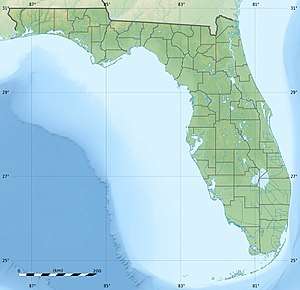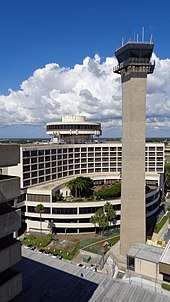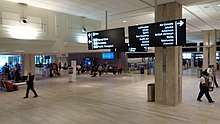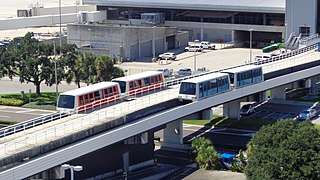Tampa International Airport
Tampa International Airport (IATA: TPA, ICAO: KTPA, FAA LID: TPA) is an international airport six miles (9.7 km) west of Downtown Tampa, in Hillsborough County, Florida, United States. The airport is publicly owned by Hillsborough County Aviation Authority (HCAA).[2] It has been praised for its architecture and Landside/Airside design of a central terminal (landside) connected by people movers to four satellite air terminals and gates (airsides), a pioneering concept when designed in the late 1960s. The airport was called Drew Field Municipal Airport until 1952.[3]
Tampa International Airport (TPA) | |||||||||||||||||||
|---|---|---|---|---|---|---|---|---|---|---|---|---|---|---|---|---|---|---|---|
 | |||||||||||||||||||
Aerial view of the airport in 2004 | |||||||||||||||||||
| Summary | |||||||||||||||||||
| Airport type | Public | ||||||||||||||||||
| Owner | Hillsborough County | ||||||||||||||||||
| Operator | Hillsborough County Aviation Authority | ||||||||||||||||||
| Serves | Tampa Bay Area | ||||||||||||||||||
| Location | Tampa / Town 'n' Country, Florida, U.S. | ||||||||||||||||||
| Opened | 1971 | ||||||||||||||||||
| Hub for | Silver Airways | ||||||||||||||||||
| Elevation AMSL | 26 ft / 8 m | ||||||||||||||||||
| Coordinates | 27°58′32″N 082°32′0″W | ||||||||||||||||||
| Website | www.TampaAirport.com | ||||||||||||||||||
| Map | |||||||||||||||||||
 TPA Location of airport in Florida / United States  TPA TPA (the United States) | |||||||||||||||||||
| Runways | |||||||||||||||||||
| |||||||||||||||||||
| Helipads | |||||||||||||||||||
| |||||||||||||||||||
| Statistics (2019) | |||||||||||||||||||
| |||||||||||||||||||
The airport is served by over twenty major air carrier airlines, four regional airlines, and three air cargo carriers. Three of the regional airlines operate under the banner of mainline air carriers, while a fourth, Silver Airways, is independent and utilizes Tampa International Airport as a hub for its operations. Southwest Airlines carries the airport's largest share of passengers, operating up to 121 daily flights.[4]
The airport presently serves 93 non-stop destinations throughout North America, Central America, the Caribbean, and Europe. The airport handled 22,497,953 passengers in 2019, making it the 28th-busiest airport by passenger movements in North America.[5]
History
Flying boat
Tampa Bay is the birthplace of commercial airline service, when pioneer aviator Tony Jannus flew the inaugural flight of the St. Petersburg-Tampa Airboat Line on January 1, 1914, from St. Petersburg, to Tampa using a Benoist Flying Boat—the first scheduled commercial airline flight in the world using a heavier-than-air airplane.[6]
Drew Field

Tampa International Airport | ||||||||||||||||||||||||||||||||||||||||||||||||||||||||||||||||||||||||||||||||||||||||||||||||||||||||||||||||||||||||||||||||||||||||||||||||||||||||||
|---|---|---|---|---|---|---|---|---|---|---|---|---|---|---|---|---|---|---|---|---|---|---|---|---|---|---|---|---|---|---|---|---|---|---|---|---|---|---|---|---|---|---|---|---|---|---|---|---|---|---|---|---|---|---|---|---|---|---|---|---|---|---|---|---|---|---|---|---|---|---|---|---|---|---|---|---|---|---|---|---|---|---|---|---|---|---|---|---|---|---|---|---|---|---|---|---|---|---|---|---|---|---|---|---|---|---|---|---|---|---|---|---|---|---|---|---|---|---|---|---|---|---|---|---|---|---|---|---|---|---|---|---|---|---|---|---|---|---|---|---|---|---|---|---|---|---|---|---|---|---|---|---|---|---|
| ||||||||||||||||||||||||||||||||||||||||||||||||||||||||||||||||||||||||||||||||||||||||||||||||||||||||||||||||||||||||||||||||||||||||||||||||||||||||||
In 1928 the city completed the 160-acre (65 ha) Drew Field six miles (9.7 km) west of Downtown Tampa. It was named for local developer John H. Drew, who formerly owned the land on which the airport stood. The more popular Peter O. Knight Airport was opened on Davis Islands near Downtown Tampa in 1935, where both Eastern and National Airlines operated until 1946.
The United States Army Air Corps began negotiating for the use of Drew Field in 1939 during the buildup of military forces prior to World War II. In 1940, the City of Tampa leased Drew Field to the U.S. Government for 25 years, or until the end of the "national emergency." During the war, the United States Army Air Forces expanded and modernized the airport. The airfield was used by the Third Air Force and renamed it Drew Army Airfield. The Third Air Force used it as a training center by 120,000 combat air crews, primarily in bomber aircraft for the European and Pacific theaters, and also flew locally based antisubmarine patrols from the airfield until that mission was fully taken over by Naval Aviation assets of the U.S. Navy and U.S. Coast Guard. There was one mishap in 1943 that killed five fliers.[7] Despite this, Drew Field set a safety record for the Third Air Force in 1945 after 100,000 flying hours had been completed over a period of 10 months without a fatal incident. The aircraft operated included the Boeing B-17 Flying Fortress, Douglas C-47 Skytrain, North American AT-6, North American B-25 Mitchell, and others.[8]
After World War II, the Army Air Forces vacated the facility and Drew Field was returned to the City of Tampa. The Peter O. Knight Airport and Drew Field reversed roles as the main Tampa airport because Drew Field was greatly expanded by the United States Army Air Forces during the war years. Airlines (Eastern Air Lines and National Airlines) moved to Drew Field from Peter O. Knight Airport on Davis Island, which was too small to handle the Douglas DC-4, DC-6 and Lockheed Constellation prop-liners then coming on line in the mid-1940s. During this period, the airlines were housed in the former Drew AAF Base Operations building.[9]
Tampa International Airport
Trans Canada Airlines international flights began in 1950 and Drew Field was renamed Tampa International Airport. The airport's second terminal opened in 1952 near the intersection of Columbus Drive and West Shore Blvd.
The April 1957 Official Airline Guide shows 30 departures a day on Eastern Air Lines: nonstops to Chicago-Midway, Detroit (Willow Run), Cleveland, New York Idlewild (now JFK), Boston, seven nonstops to Atlanta and 18 within Florida. National Airlines had 26 departures, including seven nonstops beyond Florida to Houston Hobby, Havana, Washington National, New York/Idlewild and three to New Orleans. Trans-Eastern had 12 departures and Mackey had two DC-3s, none nonstop beyond Florida. Trans-Canada had thirteen nonstops a week to Toronto or Montreal.
The 1952 terminal, built for three airlines, was swamped after the Civil Aeronautics Board granted Capital, Delta, Northeast, Northwest and Trans World Airlines authority to fly from Tampa in the late 1950s. An annex was built east of the terminal for the new carriers.
Turbine-powered flights began in 1959 on Eastern Air Lines' L-188 Electra; in 1960 National, Eastern and Delta Air Lines began jet flights with the Douglas DC-8 (Delta was first, with a Chicago nonstop in May or June). National DC-8 nonstops to Los Angeles and weekly Pan American jets to Mexico City (MIA-TPA-MID-MEX) started in 1961.
The 1952 terminal was congested as larger jets replaced piston airliners and it was again expanded.
The 1971 terminal

During the early 1960s, the aviation authority began planning a replacement terminal in an undeveloped site at the airport. Airport leaders chose the Landside/Airside design in 1965 after a study.
Construction on the new terminal designed by Reynolds, Smith & Hills began in 1968 between the airport's parallel jet-capable runways.[10] Prior to its opening on April 15, 1971, 60,000 people toured the new facility during a two-day open house. National Airlines Flight 36 from Los Angeles was the first to arrive at the terminal; after touching down at 05:26 A.M., the jet taxied to Airside E.
The graphics and signage system designed by Jane Davis Doggett used red for one group of airlines and blue for another. The red/blue color scheme began on the highway outside the airport and helped guide drivers to the proper dropoff areas for each airline, then continued to guide passengers through the airport itself and ultimately to their gate.[11] The Tampa Airport was the first airport to use this sort of color-coded wayfinding signage system which was safer for drivers and required many fewer signs than highway engineers had originally budgeted for.[12]
The logo, used since the new airport opened in 1971, represents the blue waters of Tampa Bay with a jetliner flying into the downtown Tampa sunset. It is known as the "Spirit of Flight". The jetliner was modeled after those once used for supersonic transport—at the time the logo was created in the 1970s, it was during an era when it was thought that supersonic aircraft would replace conventional jets as a mode of air travel.
On July 15, 1972, the 227-foot-tall (69 m) Air Traffic Control Tower opened, the tallest in the United States at the time. The Host/Marriott Airport Hotel and its revolving rooftop restaurant opened in December 1973, with triple-paned windows and sound-proof guest rooms.
Northwest Airlines and National Airlines brought the jumbo jet to the airport late in 1971 with the introduction of the Boeing 747 and McDonnell Douglas DC-10. This was followed by the L-1011 Lockheed Tristar a year later by Eastern Air Lines. National Airlines began trans Atlantic DC-10 service to Amsterdam and Paris in 1977.
Expansion and later developments
During the following decades, the airport was expanded to handle more traffic and additional airlines. Airside B closed in 1991, following the demise of Eastern Airlines. In 1996, Airsides C and D were remodeled, and the interiors of both satellites were refurbished. During this time, all the airlines from both facilities were housed in Airside E. Upon completion of the renovations, the airlines returned to their original locations, and Airside E was closed for good. The Landside Terminal was also remodeled numerous times during the 1980s and 1990s.
Both Delta Air Lines and US Airways opened maintenance bases at the airport. Both bases closed during the air travel downturn following the attacks of September 11, 2001. Alabama-based Pemco World Air Services now occupies the former US Airways hangar performing MRO (maintenance, repair, overhaul) services for the Spirit Airlines and jetBlue A320 fleet.[13] On April 1, 2010 a press release announced that a lease agreement was reached to allow Pemco to lease the second hangar formerly used by Delta Air Lines, where they perform Boeing 737 cargo conversions and modifications.[14] Tampa Bay is one of the largest metropolitan areas in the United States that doesn't have a major airline hub.
Phase I of the economy parking garage was completed in November 2005.[15] Phase II of the economy garage opened ahead of schedule in November 2005, bringing a total of 5,600 parking spaces.[16]
On March 7, 2011, federal officials gave TPA the green light to begin charter flights to Cuba as an official entry/exit point.[17][18]
Future
A second Landside Airside Terminal will be built to the north of the current facility, allowing the airport to serve over 50 million passengers a year by 2025. Construction of this facility was originally slated to begin in 2010, with completion set to October 2015. However, the St. Petersburg Times reported on November 7, 2008 that the airport authority is no longer pursuing the original planned dates due to the Great Recession. The early 2010s struggle of the airline industry, including the merger by Delta and Northwest, resulted in passenger enplanements to level off. According to the Tampa Tribune, passenger levels dropped by 14% in January 2009.[19]
Plans are currently in the works for the construction of an intermodal facility located on airport premises. This would allow passengers to better connect to the number of proposed bus routes by both HART and PSTA. In addition, a light rail system is being planned for the Tampa area, with a link to TPA Airport from Downtown Tampa and the WestShore district.[20]
In 2012, a master plan was released involving the airport facilities in the future. It outlined that instead of building a new terminal (north of the original), the terminal would be expanded to accommodate up to 34 million passengers per year. This included the construction of Airside D. There will also be the addition of the international arrivals curbside and a new Security Checkpoint for airside C and D.[21]
Groundbreaking for Phase I occurred on November 4, 2014.[22] The first phase involved the construction of new passenger facilities including a remote car rental facility and a new people mover system to connect the rental car facility and Economy Parking garage with the terminal. The Rental Car Center and SkyConnect people mover opened to the public on 14 February 2018.
In April 2017 Tampa International Airport released details of a $543 million Phase II of its expansion project which is expected to begin construction in mid-2018. The expansion includes express curbside drop-off for passengers without checked bags, widening the George Bean Parkway in and out of the airport, and development of the "Gateway" commercial development of 17 acres (6.9 ha) of airport property. Plans include a hotel, office buildings, a retail strip, and a gas station.[23][24]
Facilities
Airport amenities
Airport conveniences that are free of charge include passenger paging, wireless Internet access, cell phone waiting lot with flight information, shuttle service from the economy garage, real-time flight information and travelers aid services. Other services include eateries located before passenger checkpoints, touch screen information kiosks, information about local events and outdoor smoking areas. In June 2012, the airport debuted several distinctly-Tampa restaurants and bars in both the Landside Terminal and the airsides. Among these eateries now represented at the airport are the iconic Ybor City Columbia Restaurant, downtown's Mise en Place's First Flight wine bar, and Cigar City Brewing's brewpub, which features an on-site-produced pale ale named after Tampa aviation pioneer Tony Jannus.[25] A permanent exhibit of Tony Jannus Award winners is also located in the airport.
Landside Terminal

The Landside Terminal was designed with convenience in mind. Express elevators and escalators keep passenger traffic moving smoothly, with few bottlenecks.
Level 1 (Baggage Claim) contains all inbound baggage facilities and baggage belts. The Blue Rental Car facility was relocated from its original Bag Claim location, to a consolidated facility beneath the long-term-parking garage in 2002. On November 15, 2006 a new Red Rental Car facility and garage opened adjacent to the Marriott.[26] In late 2008, renovation of the baggage claim began. Improvements include new baggage carousels and an inbound baggage screening system. This project was completed in 2010. In 2013, plans for a consolidated car rental center were announced, to be located on the south end of the property and connected to the terminal via a people mover.[27]
Level 2 (Ticketing) contains all ticketing/check-in functions. The level also contains a Charter desk reserved for flights that do not normally utilize TPA. The Ticketing area received a major renovation/expansion in 2002, and again in 2013.
Level 3 (Transfer Level) includes the airside shuttle stations and a shopping area known as the Airport Galleria. The airport Marriott Hotel is adjacent to the main terminal. Tampa's facilities are almost entirely housed in the public access main terminal. The facilities are mostly operated and run by airport retail companies—HMS Host, Stellar Partners, Bay Area Concessions, and OSI Restaurant Partners.
- Level 3 has undergone numerous major renovations. The main building was renovated in 1997. Shuttle bay expansions were constructed in 1986 for Airside F, 1994 for Airside A, 2001 for Airside E, and 2004 for Airside C. Future expansion plans include a relocation of the shuttle bay for Airside E by 2012. In February 2018, SkyConnect, a tram connecting the Economy Parking Garage and a replacement Rental Car facility, opened to the public.
Service building
When the airport opened its doors in 1971, the Service Building went into operation as well. It housed the very first Communications Center, police dispatch, employee cafeteria and maintenance locker rooms. The building is located across from the Red Baggage and Ticketing levels. It was primarily intended to house mechanical equipment such as the chiller plant and electrical transformers. Since then it has been expanded to two levels which was in the original design in 1968. Today it houses the original facilities with the addition of offices, rental car counters, badging and a receptionist desk. The police department/Lost & Found has a lobby on level two (ticketing level) for walk-in lost & found requests.
Terminals

Today, Tampa International Airport handles 21.2 million passengers per year,[28] and improvements currently in progress will increase capacity to 34 million passengers a year. The airport's car rental market is in the top five among all U.S. Airports.
Tampa International Airport's Landside/Airside terminal was the first of its type in the world.[29] There is a central Landside Terminal where baggage and ticketing functions take place. The Landside Terminal is surrounded by four Airside satellites where airliner embarkment and disembarkment occur. Each Airside is connected to the Landside Terminal via an elevated automated people mover (APM) system which employs 16 Bombardier Innovia APM 100 Shuttle Cars. TPA was the first airport in the world to deploy a fully automated, driver-free people mover system and is host to Bombardier Transportation's longest-running APM system. The terminal was originally designed to limit the walking distance between the automobile and airliner to 700 feet (210 m); today, it has increased to about 1,000 feet (300 m), due mostly in part to the larger, more modern airside buildings which have replaced the original, smaller structures.
In contrast to a similar landside/airside terminal design used at Orlando International Airport, passengers must first access the APM system before going through the security checkpoints, as the security checkpoints are located in the airsides (though boarding passes are inspected before boarding the people movers so only ticketed passengers or those with the TPA All Access airside access program have access to them).
Airsides

Today, there are four active airsides (A, C, E, and F) with 59 gates. All were constructed after 1985 and all airsides include a food court and gift shop, as well as outdoor smoking patios. Airsides E and F contain duty-free shops in addition to the regular gift shops to serve passengers arriving or departing on international flights.[30][31] As of 2011, the security screening area in each airside is equipped with Advanced Imaging Technology (AIT) walk-through detection machines, made by L3 Communications, whose devices use millimeter wave technology and not backscatter X-ray.
- Airside A
- Includes gates 1–12 and 14–18 (16 total).
- Serves Contour, JetBlue, Silver Airways, Spirit, and United.[32]
- It was opened on March 16, 1995 and was designed by Hellmuth, Obata and Kassabaum.[33]
- It features a space designated for use by an airline lounge (intended to be a Continental Airlines President's Club); however, it is unused.
- Airside C
- Largest airside by area.
- Includes gates 30–45 (16 total).
- Serves Alaska, Southwest and Sun Country.[32]
- It was the last airside to be demolished and rebuilt from the ground up; it was designed by architect Alberto Alfonso and reopened to passengers on April 19, 2005.
- Designed by HNTB and Alfonso Architects.[34]
- Airside E
- Includes gates 62–75 (13 total).
- Serves Air Canada, Delta (with international arrivals to use Airside F), Frontier and WestJet. It also is used by Swift Air for seasonal charters.[32]
- It was the first airside to be demolished and rebuilt.
- The current 14-gate facility was designed for Delta and was dedicated and opened to passengers on October 15, 2002.
- The facility includes one airline lounge: the Delta Air Lines Sky Club.
- Designed by Hellmuth, Obata and Kassabaum.[35]
- Airside F
- Includes gates 76–90 (14 total).
- International Airside; Serves American, British Airways, Cayman Airways, Copa Airlines, Edelweiss Air, Lufthansa, Norwegian Air Shuttle, and Swoop. Charters to Cuba depart from airside F.
- It was opened on November 4, 1987 and was designed for international flights.
- The facility includes two airline lounges: the American Airlines Admirals Club and the International Club which is used by British Airways passengers.
- The customs/immigration center is located on level 1.
- Designed by Design Arts Group, Inc. and Rowe Holmes Hammer Russell Architects Inc.[36]
Original airsides
The original TPA airsides were designed in the mid-1960s as four identical facilities. The concept was later scrapped for unknown reasons and the facilities were eventually built around the requirements of their then primary tenant airlines. Thus creating the four dissimilar facilities that stood from their opening in 1971 to 2000. Each airside building was three stories tall and included a minimum of ten gates, a cocktail lounge, snack bar, and gift shop. Each airside was maintained by the airline for which it was built until 1999. All of the facilities (except Airside B) were renovated in the early/mid-1990s but received no further modifications during their life span. All 4 of the original airside buildings have been demolished and either re-built or the space re-used as noted below.
Below is a brief description of the four original airsides and the airlines that occupied them throughout the years. The bolded airlines indicate the primary (anchor) tenants for each facility.
- Airside B – former Gates 19–30 (1971–1991)
- Airside B was a 12-gate facility that was designed by Eastern Air Lines and was the first original airside to shut down. The closure was the direct result of Eastern's cessation of operations in 1991. There were preliminary plans to renovate and revive the airside during the early 1990s, but efforts failed and planning for Airside A commenced immediately in 1992. The airside was not rebuilt due to a lack of overnight parking for aircraft, the facility's close proximity to one of TPA's runways, and the need for a separate automated baggage sorting facility for Airside A (since Airside A could not accommodate a built-in facility due to its pre-2001 construction), and was eventually demolished in 2003.
Today an overnight aircraft hardstand and an automated baggage sorting facility for Airside A sit on the former site. The site could also one day house an intermodal center that would allow passengers to connect to various mass transit options, including Tampa's proposed light rail system.
- Airside C – Gates 31–41
- Airside C was an 11-gate facility designed by Delta. The facility originally housed a customs/immigration center for arriving Air Canada and Pan Am international flights. The center was closed in 1987 and a Delta Crown Room (now known as a Delta Sky Club) was added. The airside was renovated (and its shuttles replaced) in 1996 but never received any further modification. By the late 1990s, Delta's presence in Airside C was dramatically increasing, and so was the congestion and lack of gate space. The airline soon requested HCAA to build a new facility for them. Airside E was deemed inactive by 1997 and its future quickly went up in the air. In 1998, it was decided that Airside E be demolished and rebuilt for Delta. After a brief halt in construction due to the 9/11 attacks, the new Airside E opened in 2002 and Delta immediately moved in. After much debate by the HCAA about whether to demolish or renovate the aging facility, Airside C was then slated for demolition and replacement in 2003.
- Airside D – former Gates 46–55 (1971–2005)
- Airside D was the last of the original airsides to close. The facility was designed by Northwest and was originally without some jet-ways until government airline regulation ended in 1978. The airside was renovated in 1996 (and its original shuttles were replaced). Northwest moved to Airside A in 1999 and United moved to the rebuilt Airside E in 2002. Airside D ceased operations in May 2005 after AirTran and JetBlue relocated to Southwest's former gates at Airside A. Demolition began in January 2007, and was completed in May 2007. The site of the demolished airside is currently used as a hard-stand for aircraft parking, but will eventually be used for a replacement airside, with construction beginning sometime in 2020.[37]
- Airside E – Gates 61–70
- The original Airside E was designed by National Airlines and boasted a slightly different layout from the other airsides. Its boarding gates were on the third level (as opposed to the second level in the other airsides). This was due to the fact that the facility was designed specifically for the DC-10. The first level was open to allow tugs to drive right through. This was due to the airsides close proximity to the taxiway. Airside E housed National until its demise and takeover by Pan Am. Pan Am, in turn, occupied the facility until its own demise. Thereafter, the facility was renovated (in 1991) and Continental became its final major tenant. The facility was closed in 1995 after Continental's new terminal (Airside A) opened. The airside was demolished in 2000 and replaced by its current facility.
People movers

The airport's airside automated people mover systems opened in 1971 along with the current terminal, and are the first such systems in the world to run within an airport. The original eight C-100 trains were built by Westinghouse. They were replaced in 1993 with Bombardier Innovia APM 100 trains.
The Universal Mobility Incorporated UM III people mover was installed in 1991 when the new long-term-parking garage was built and opened on December 16. It was the first of its kind in the world to include six driverless, electrically propelled cars that are completely computer controlled. The system was also the first to have active switches and it is monitored from the airport's communications center. There are four long-term stations. The Monorail circles the long-term-parking garage and connects to the short term garage via an elevated bridge to stop at four additional stations. The Monorail is free to use and runs 24 hours a day except for a once-a-week maintenance shut-down in the overnight hours. Bombardier Transportation maintains the system by contract and the Aviation Authority owns it. Thales Rail Signalling Solutions won a contract in 2008 to completely upgrade the computer control system. The upgrade was implemented and tested for an entire year. The only visible change to passengers is the station graphics which show the position of each monorail car and display system status information.[38]
On February 14, 2018, SkyConnect, a new 1.5-mile (2.4 km) people mover link was opened which connects the main terminal to the new Rental Car Center. Along the route, the SkyConnect also serves the Remote Economy Parking structure,[39] located between the terminal, and the Rental Car Center. Mitsubishi Heavy Industries America, together with Sumitomo Corporation, constructed and supplied the technology for the new line, including 12 Crystal Mover trains and five years of system operations and maintenance.
Runways
Tampa International Airport covers an area of 3,300 acres (1,300 ha) at an elevation of 26 feet (7.9 m) above mean sea level. It has three runways: 10/28 is 6,999 by 150 feet (2,133 × 46 m) with an asphalt/concrete surface; 19L/1R is 8,300 by 150 feet (2,530 × 46 m) with an asphalt/concrete surface; 19R/1L is 11,002 by 150 feet (3,353 × 46 m) with a concrete surface.[2] On January 13, 2011 the runway designations changed due to a shift in the magnetic headings. 9/27 became 10/28, 18R/36L became 1L/19R, 18L/36R became 1R/19L.[40]
Airlines and destinations
Passenger
| Domestic destinations map |
|---|
 Tampa Dulles Boston Columbus Trenton St. Louis Milwaukee Fort Lauderdale Baltimore Birmingham Dallas–Love Manchester New Orleans Madison Akron Domestic destinations from TPA (excludes Puerto Rico) |
Cargo
| Airlines | Destinations |
|---|---|
| Amazon Air | Baltimore, Chicago/Rockford, Cincinnati, Dallas/Fort Worth, Miami, Phoenix–Sky Harbor, Portland (OR), Sacramento, Stockton, Wilmington, OH |
| FedEx Express | Fort Lauderdale, Fort Worth/Alliance, Greensboro, Indianapolis, Jacksonville, Memphis Seasonal: Atlanta, Los Angeles, Newark, New Orleans, Raleigh/Durham, Tallahassee |
| UPS Airlines | Dallas/Fort Worth, Fort Myers, Jacksonville (FL), Louisville, Orlando, Philadelphia Seasonal: Columbia (SC), Jackson (MS), Miami, San Juan |
Statistics

.jpg)
.jpg)

Top airlines
| Rank | Carrier | Passengers | Share | Change
2018/19 |
|---|---|---|---|---|
| 1 | Southwest Airlines | 6,891,808 | 30.63% | |
| 2 | Delta Air Lines | 3,862,583 | 17.17% | |
| 3 | American Airlines | 3,522,031 | 15.65% | |
| 4 | United Airlines | 2,254,495 | 10.02% | |
| 5 | Spirit Airlines | 1,997,233 | 8.88% | |
| 6 | JetBlue | 1,267,391 | 5.63% | |
| 7 | Frontier Airlines | 1,263,862 | 5.62% | |
| 8 | Air Canada | 316,701 | 1.41% | |
| 9 | British Airways | 172,014 | 0.76% | |
| 10 | Silver Airways | 161,718 | 0.72% | |
| Others | 788,117 | 3.50% | ||
| Total | 22,497,953 |
Top domestic destinations
| Rank | City | Passengers | Carriers |
|---|---|---|---|
| 1 | 1,032,090 | Delta, Frontier, Southwest, Spirit | |
| 2 | 446,640 | American, Frontier, Spirit, United | |
| 3 | 443,830 | American | |
| 4 | 402,090 | JetBlue, Spirit, United | |
| 5 | 396,860 | American, Frontier, Southwest, Spirit | |
| 6 | 380,560 | American, Spirit | |
| 7 | 357,040 | Frontier, Southwest, United | |
| 8 | 349,110 | Delta, Southwest, Spirit | |
| 9 | 343,850 | Delta, JetBlue, Spirit | |
| 10 | 337,510 | Southwest, Spirit |
Top international destinations
| Rank | City | Passengers | Change
2017/18 |
Carriers |
|---|---|---|---|---|
| 1 | 324,605 | Air Canada, Air Transat, WestJet | ||
| 2 | 151,505 | British Airways, Norwegian Air Shuttle | ||
| 3 | 120,601 | Lufthansa | ||
| 4 | 114,165 | Charters, Southwest | ||
| 5 | 56,670 | Copa Airlines | ||
| 6 | 40,645 | Cayman Airways | ||
| 7 | 33,987 | Edelweiss | ||
| 8 | 24,942 | Air Canada, Air Transat | ||
| 9 | 20,501 | Air Canada, WestJet |
Aircraft
For the 12-month period ending December 31, 2019, the airport had 217,360 aircraft operations, an average of 596 per day: 85% domestic commercial, 4% international commercial, 11% general aviation and <1% military.[73] In May 2019 there were 68 aircraft based at this airport: 54 jet, 7 single-engine, and 7 helicopter.[2] As of January 2020, the largest passenger aircraft serving TPA on a scheduled basis is the Boeing 777.
Access
Color-coding system
Since its opening on April 15, 1971, Tampa International Airport has used a special color-coding system throughout the terminal complex. The baggage claim areas and ticket counters are color-coded blue and red. Airlines are assigned a color depending on their location within the Landside Terminal Building. The airlines found in the south side of the terminal are color-coded blue. The carriers located in the north side are color-coded red. The codes were also assigned names based on aviation and aerospace pioneers in order to assist color-blind patrons. The Blue side names are Neil Armstrong and Amelia Earhart. The Red side names are Igor Sikorsky and Chuck Yeager. Since the opening of SkyConnect, a third set of elevators have been opened on each side by the SkyConnect entrance (Blue East and Red East), but neither core is currently named. The long-term-parking garage also uses the special color-coding system. The four elevator cores have names and colors to make it easier for customers to remember where they parked. Wright Brothers—orange, Tony Jannus—purple, Robert Goddard—green and Charles Lindbergh—brown. The economy parking garage (EPG) elevator cores are designated as purple, gold, green, and orange, but none are currently named. It is currently unclear if there are any color designations assigned to the elevators at the Rental Car Center.
Parking facilities
Currently, over 20,000[74] parking spaces are available at the airport. These spaces are split between the short-term-parking garage, the long-term-parking garage, and the economy parking garage. As of now, there is an ongoing expansion of the Economy Parking Garages, which is in its second phase of construction. The SunPass Plus program, first introduced at Orlando International Airport, is being implemented at TPA in stages. In early 2009, the Economy Parking Garages began using the program, in which customers can use their SunPass transponders to pay for parking. The program was expanded to the short- & long-term garages during the summer of 2009.[75] TIA also provides self-serve lanes in which customers can pay via credit card instead of waiting in line for the cash lanes.
Short-term-parking garage
Levels 4–9 of the Landside Terminal Building house the short-term-parking garage. The garage was built with the airport complex in 1971 for added passenger convenience. Originally three levels, the garage was expanded in 1982 to six levels and contains 3,612 spaces.
Long-term-parking garage
Long-term-parking was originally a large lot sitting on what is today, the present-day long-term-parking garage. The garage was built in several phases from 1990 to 1997 after increased passenger traffic swamped the parking lot beyond capacity. A monorail (situated on Level 7 of the garage) connects passengers to and from the short-term-parking garage (Level 5) and the Landside Terminal. The garage can hold a total of 7,635 spaces on six levels.
Economy parking garage
On November 1, 2005 phase I-A of the garage opened to the public and then on May 19, 2006 phase I-B opened. The garage is 8,043 spaces large and is divided into two color-coded sections—purple and gold (yellow). There is also a surface lot and overflow lot for use during the holidays. Before the SkyConnect opened, a free shuttle service takes passengers to the terminal drop-off twenty-four hours a day. Construction began in early 2008 on phase II which will be an exact copy of the first phase. In February 2018, the SkyConnect people mover began operations, linking the Economy garage with the Main Terminal.
Cell phone waiting lot
In an effort to decrease congestion within the Landside Terminal, particularly the baggage claim areas, a cell phone waiting lot was built alongside one of the remote overflow lots. It includes two large four panel flight status boards, showing real-time arrival information. This allows awaiting family members and friends of arriving passengers to wait in their vehicles until the passenger calls. Then the arriving passenger(s) can be picked up curbside at the Landside Terminal without creating curbside congestion problems. The lot has restrooms, WiFi, recorded CCTV surveillance and around-the-clock police patrols. Construction began in early 2008 to expand the cell phone waiting lot and was completed in November of that same year. The lot contains approximately 125 striped spaces.
Rental Car Center
On February 14, 2018, a new 2.6-million-square-foot Rental Car Center with space for 5,300 vehicles, was opened to the public. The new combined service and maintenance facility is located near the southern edge of airport property and is connected to the terminal via a new train called SkyConnect. Passengers on most domestic flights also have the ability to check their luggage inside the Rental Car Center. Rental car services were originally located adjacent to the Landside terminal, near the long-term-parking structure; however, relocation was necessary to accommodate more cars and rental car companies as the facilities were at or near capacity.[76]
Public transit
On the southwest end of the Rental Car Center is a canopy and platform that is used for both Hillsborough Area Regional Transit and Pinellas Suncoast Transit Authority bus services. The bus hub is accessible via a bank of elevators that connect directly to the Rental Car Center and is steps away from the SkyConnect station. With the upcoming 2nd phase of expansion at the airport, the intent is to expand upon the existing platform to eventually allow bus services from Pasco and perhaps even Hernando Counties to connect into the airport directly. The land immediately to the south of the Rental Car Center can also be configured for future light rail or commuter rail services if plans come to fruition.
Awards
In 2007 and 2008, Zagat Survey ranked TPA the Best Overall U.S. Airport, while placing it second-best overall in 2009 and 2010. In 2008 Condé Nast Traveler recognized TPA as the second-best airport in the world, just two tenths of a point behind the first-place winner. JD Power and Associates have also given TPA Airport consistently high customer-satisfaction ratings over the years. In November 2011, CNN ranked TPA sixth among ten of the world's most loved airports, being the only one on the list from the US.[77] In 2016, it was named one of the Top 3 airports in the country by Condé Nast.[78]
Accidents and incidents
- On March 9, 1943, five USAAF flight crew were killed when their Martin B-26 Marauder crashed on a flight from Avon Park Auxiliary Field to Eglin Field. The pilot attempted an emergency landing at Drew Field and overshot the runway. Two others on board the B-26 survived. This occurred one hour after a USAAF Douglas A-24 flying out of Drew Field crashed in Mullet Key near St. Petersburg, a bombing range at the time. The pilot ditched the airplane and lived, but the gunner bailed out and drowned.[7][79]
- On November 6, 1986, an Eastern Air Lines Captain, George Baines, age 56, was flying in his private aircraft, a Piper PA-23 Apache, (registration N2185P) from his home to Tampa International Airport to catch a flight. Captain Baines was cleared for an instrument landing system approach to runway 36L (now 1L) with 1⁄16-mile (0.10 km) visibility in dense fog. He was unable to land during his first approach and declared a missed approach and executed a go-around to try again. On the second approach, the Apache touched down on taxiway W, parallel to and about 406 feet (124 m) to the right (east) of runway 36L. At the same time, a Pan American Boeing B-727 was proceeding southbound on taxiway W. When the captain of the Pan-Am 727 saw the Apache emerge from the dense fog directly in front of him, he turned to the right (west) in an attempt to avoid the impending collision. About 2 seconds later, the Apache's left engine struck the B-727 in the radome, which is a structural, weatherproof enclosure that protects a radar antenna. Two passengers and a flight attendant were injured after they evacuated the aircraft. The Apache was almost destroyed and the pilot, the sole occupant of the aircraft, was killed. The primary causes of this accident was determined by the NTSB to include the pilots decision to continue his approach below decision height when the visibility was below landing minimums and the adequacy of current Federal regulations that allow pilots operating under Part 91 to conduct approaches when the reported visibility is below published minimum visibility for land.[80]
References
![]()
- "Tampa International Airport surpasses 20 million passenger mark in record fiscal year". www.tampaairport.com. Archived from the original on October 17, 2018. Retrieved October 16, 2018.
- FAA Airport Master Record for TPA (Form 5010 PDF), effective May 7, 2009.
- Roger Sandoval (February 23, 1928). "TPA | About TPA | DrDrew Field History". Tampaairport.com. Archived from the original on January 6, 2013. Retrieved November 27, 2012.
- "Archived copy" (PDF). Archived (PDF) from the original on May 9, 2015. Retrieved April 17, 2015.CS1 maint: archived copy as title (link)
- "Tampa International Airport fact sheet - 2016" (PDF). www.tampaairport.com. Archived (PDF) from the original on March 31, 2017. Retrieved March 30, 2017.
- Brown, Warren J. (1994). Florida's Aviation History. Largo, Florida: Aero-Medical Consultants. p. 56. ISBN 0-912522-70-4.
- Dead Listed in Drew Field Crash Archived March 5, 2017, at the Wayback Machine St. Petersburg Times, March 11, 1943
- Drew Field Sets Safety Record Archived March 5, 2017, at the Wayback Machine Saint Petersburg Times, September 30, 1945
- "Drew Field Municipal Airport History". Archived from the original on January 6, 2013.
- "Tampa Airport Captures Excellent Structure Award". Evening Independent. September 27, 1972. Archived from the original on March 5, 2017. Retrieved June 16, 2012.
- Knapp, Pat Matson; Turner, Tracy (November 7, 2013). "Jane Davis Doggett: Environmental Graphics Pioneer". Eg Experiential Graphics Magazine. No. 07: 50. Archived from the original on January 14, 2015. Retrieved April 7, 2014.
- Conniff, James C. G. (March 30, 1975). "Danger: Signs Ahead". New York Times Magazine. p. 36.
- "PEMCO". Pemcoair.com. December 16, 2009. Archived from the original on March 3, 2012. Retrieved November 27, 2012.
- "Pemco expands operations" (PDF). www.tampaairport.com. Archived from the original (PDF) on November 29, 2010. Retrieved October 23, 2015.
- St. Petersburg Times, A New Day for Parking. Archived November 25, 2005, at the Wayback Machine
- "Homepage - Tampa International Airport". www.tampaairport.com. Archived from the original on June 21, 2003. Retrieved July 7, 2003.
- TBO.com (March 7, 2011). "Tampa International gets federal OK for charter flights to Cuba". TBO.com. Archived from the original on March 14, 2011. Retrieved November 27, 2012.
- "TIA To Open for Cuba Charter Flights | Representative Kathy Castor". Castor.house.gov. January 14, 2011. Archived from the original on July 22, 2011. Retrieved November 27, 2012.
- TBO.com (February 13, 2009). "TIA Passenger Traffic Down 14 Percent in January". TBO.com. Retrieved November 27, 2012.
- "Transitway Planning, Tampa International Airport". Archived from the original on May 14, 2008. Retrieved May 29, 2008.
- Master Plan Archived April 19, 2012, at the Wayback Machine, Tampa International airport
- "Story Map Tour". Archived from the original on January 23, 2016. Retrieved January 23, 2016.
- "Tampa International Airport details $543 million second phase of massive construction plan". Tampa Bay Times. Archived from the original on April 22, 2017. Retrieved April 21, 2017.
- "Tampa, FL airport officials unveil details for $543M phase of $2.3B master plan". Construction Dive. Archived from the original on April 22, 2017. Retrieved April 22, 2017.
- "Tampa Airport welcomes local flavor" (PDF). www.tampaairport.com. Archived from the original (PDF) on September 20, 2012. Retrieved October 23, 2015.
- Bay News 9, Bay Area Briefs. Archived September 27, 2007, at the Wayback Machine
- "New vision for Tampa International Airport cleared for takeoff | Tampa Bay Times". Tampabay.com. April 4, 2013. Archived from the original on July 1, 2013. Retrieved July 5, 2013.
- "Archived copy" (PDF). Archived (PDF) from the original on July 14, 2018. Retrieved August 12, 2018.CS1 maint: archived copy as title (link)
- Tampa International Airport, History Archived February 25, 2009, at the Wayback Machine
- Roger Sandoval. "TPA | Shops and Restaurants | Airside E". Tampaairport.com. Archived from the original on November 11, 2012. Retrieved November 27, 2012.
- Roger Sandoval. "TPA | Shops and Restaurants | Airside F". Tampaairport.com. Archived from the original on December 20, 2012. Retrieved November 27, 2012.
- "Airlines at TPA | Tampa International Airport". www.tampaairport.com. Archived from the original on June 20, 2017. Retrieved June 19, 2017.
- "Tampa International Airport Expansion Features Hook-On Suspended Metal Ceiling System" (PDF). Archived (PDF) from the original on September 23, 2015. Retrieved June 16, 2012.
- "Airside C Grand Opening – Tampa International Airport" (PDF). Archived from the original (PDF) on June 24, 2012. Retrieved June 16, 2012.
- Cronan, Carl (October 21, 2002). "Contractor Works All Angles to Finalize TIA's Airside E". Tampa Bay Business Journal. Archived from the original on February 26, 2015. Retrieved June 16, 2012.
- "Modernism Links Diverse Collection of Top Buildings". The Miami Herald. October 22, 1989. Archived from the original on September 5, 2014. Retrieved June 16, 2012.
- "HCAA Board approves Phase 2 budget amendment | Tampa International Airport". www.tampaairport.com. Archived from the original on March 6, 2018. Retrieved February 25, 2018.
- "SelTrac® CBTC, Communications-Based Train Control For Urban Rail – Thales". Thalesgroup.com. Archived from the original on February 24, 2012. Retrieved July 5, 2013.
- Tampa Airport (May 6, 2015). "Virtual Tour of Tampa International Airport Expansion - Part 1". Archived from the original on March 5, 2017. Retrieved January 23, 2016 – via YouTube.
- "GA newsletter fall 2010" (PDF). www.tampaairport.com. Archived from the original (PDF) on March 4, 2012. Retrieved October 23, 2015.
- "Flight Schedules". Air Canada. Archived from the original on March 23, 2018. Retrieved March 27, 2018.
- "Flight Timetable". Archived from the original on February 2, 2017. Retrieved March 31, 2018.
- "British Airways - Timetables". Archived from the original on February 27, 2017. Retrieved March 31, 2018.
- "Cayman Airways Flights Schedule". Archived from the original on March 5, 2018. Retrieved March 31, 2018.
- "Flight Schedule". Archived from the original on August 10, 2017. Retrieved March 31, 2018.
- "Archived copy". Archived from the original on October 3, 2019. Retrieved October 6, 2019.CS1 maint: archived copy as title (link)
- "FLIGHT SCHEDULES". Archived from the original on June 21, 2015. Retrieved March 31, 2018.
- "Timetable". Archived from the original on January 14, 2018. Retrieved March 31, 2018.
- https://www.flyfrontier.com/travel/my-trips/route-map/?mobile=true
- https://www.bizjournals.com/albany/news/2020/06/18/frontier-airlines-albany-to-tampa-nonstop.html
- "Frontier". Archived from the original on September 12, 2017. Retrieved March 31, 2018.
- "JetBlue Will Add 30 New Routes, Launch Mint® Service at Newark" (Press release). JetBlue Airways. June 18, 2020. Retrieved June 18, 2020.
- "JetBlue Airlines Timetable". Archived from the original on July 13, 2013. Retrieved March 31, 2018.
- "Timetable - Lufthansa Canada". Lufthansa. Archived from the original on November 9, 2017. Retrieved March 31, 2018.
- "All destinations". Norwegian Air Shuttle ASA. Archived from the original on June 13, 2018. Retrieved June 25, 2018.
- Davies, Phil (June 25, 2018). "Norwegian announces Gatwick-Tampa service". Travel Weekly. Travel Weekly Group. Archived from the original on June 25, 2018. Retrieved June 25, 2018.
- "Silver Airways Destinations-Charleston SC". Retrieved February 26, 2020.
- Liu, Jim. "Silver Airways moves Charleston SC launch to July 2020". Routesonline. Retrieved April 30, 2020.
- "Route Map and Timetables". Archived from the original on October 11, 2019. Retrieved September 17, 2019.
- "Archived copy". Archived from the original on October 16, 2018. Retrieved October 16, 2018.CS1 maint: archived copy as title (link)
- https://www.southwest.com/air/flight-schedules/index.html?clk=GFOOTER-FLY-FLTSCHEDULES
- "Archived copy". Archived from the original on August 15, 2019. Retrieved August 15, 2019.CS1 maint: archived copy as title (link)
- "Southwest Airlines Route Map". Archived from the original on August 30, 2018. Retrieved August 31, 2018.
- "Where We Fly". Spirit Airlines. Archived from the original on December 23, 2017. Retrieved March 31, 2018.
- "Route Map & Flight Schedule". Archived from the original on August 15, 2018. Retrieved March 31, 2018.
- https://www.aviationpros.com/airlines/news/21086207/swoop-releases-its-2019-winter-schedule-adds-los-cabos-to-its-network%5B%5D
- "Where we fly" Archived August 23, 2018, at the Wayback Machine, Swoop, 27 March 2019 Retrieved on 01 April 2019.
- "Timetable". Archived from the original on January 28, 2017. Retrieved March 31, 2018.
- "Flight schedules". Archived from the original on February 10, 2017. Retrieved March 31, 2018.
- "Airline Activity Report and Financial Archives Dec19 Market Share (CYTD) | Tampa International Airport" (PDF). www.tampaairport.com. Retrieved January 18, 2020.
- "RITA | BTS | Transtats". transtats.bts.gov. March 2020. Archived from the original on May 11, 2015. Retrieved June 18, 2020.
- "U.S. International Report Passengers". US Department of Transportation. July 31, 2018. Archived from the original on July 19, 2019. Retrieved July 31, 2018.
- "TPA Monthly Activity Report" (PDF).
- "Archived copy" (PDF). Archived from the original (PDF) on February 27, 2009. Retrieved September 24, 2008.CS1 maint: archived copy as title (link)
- Roger Sandoval (October 15, 2010). "TPA | Parking". Tampaairport.com. Archived from the original on November 15, 2012. Retrieved November 27, 2012.
- "Master Plan Facts - Tampa International Airport". www.tampaairport.com. Archived from the original on January 30, 2016. Retrieved January 23, 2016.
- Rane, Jordan. "10 of the world's most loved airports". CNNGo. Archived from the original on December 3, 2011. Retrieved December 1, 2011.
- "The 10 Best Airport in the U.S." Condé Nast. October 26, 2016. Archived from the original on April 18, 2017. Retrieved April 17, 2017.
- Five Are Killed As Bombers Crash Archived March 5, 2017, at the Wayback Machine The Evening Independent, March 10, 1943
- "Aircraft Accident Report - NTSB" (PDF). www.ntsb.gov. 2015-10-23. Archived (PDF) from the original on March 30, 2016.
External links
| Wikimedia Commons has media related to Tampa International Airport. |
- TPA Airport Master Plan
- Tampa International Airport, official site
- Juan's Tampa International Airport Fan-Page
- A Community Rally For More Direct Flights From Tampa International Airport
- Drew Field Echoes, military newspaper for 1942–1945 when the airport was a military air field
- FAA Airport Diagram (PDF), effective June 18, 2020
- FAA Terminal Procedures for TPA, effective June 18, 2020
- Resources for this airport:
- AirNav airport information for KTPA
- ASN accident history for TPA
- FlightAware airport information and live flight tracker
- NOAA/NWS weather observations: current, past three days
- SkyVector aeronautical chart for KTPA
- FAA current TPA delay information

